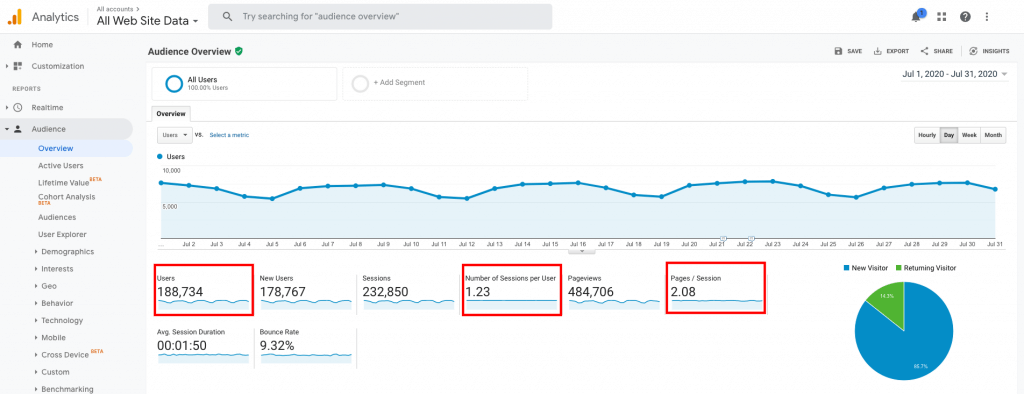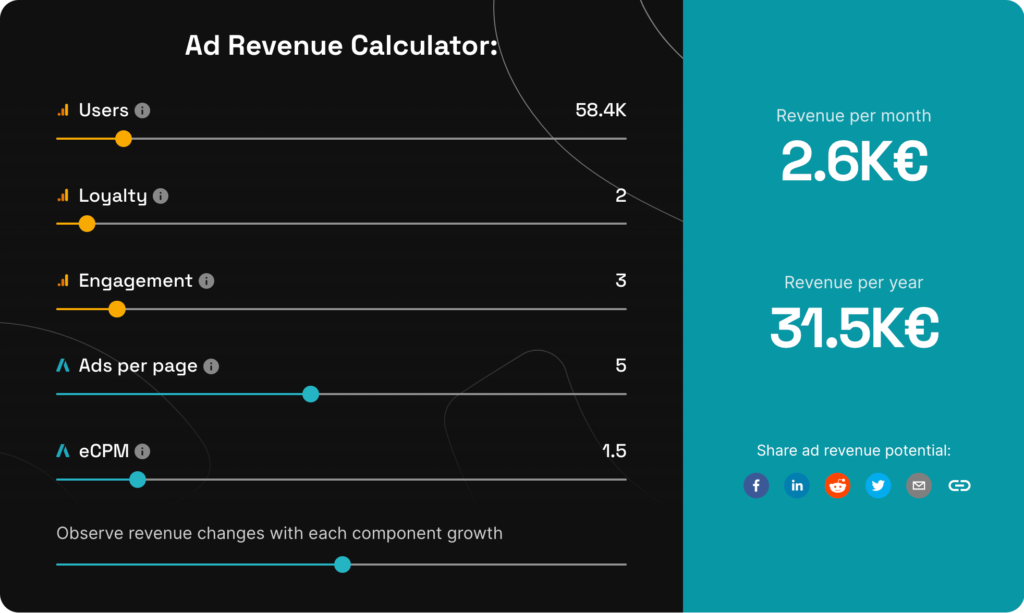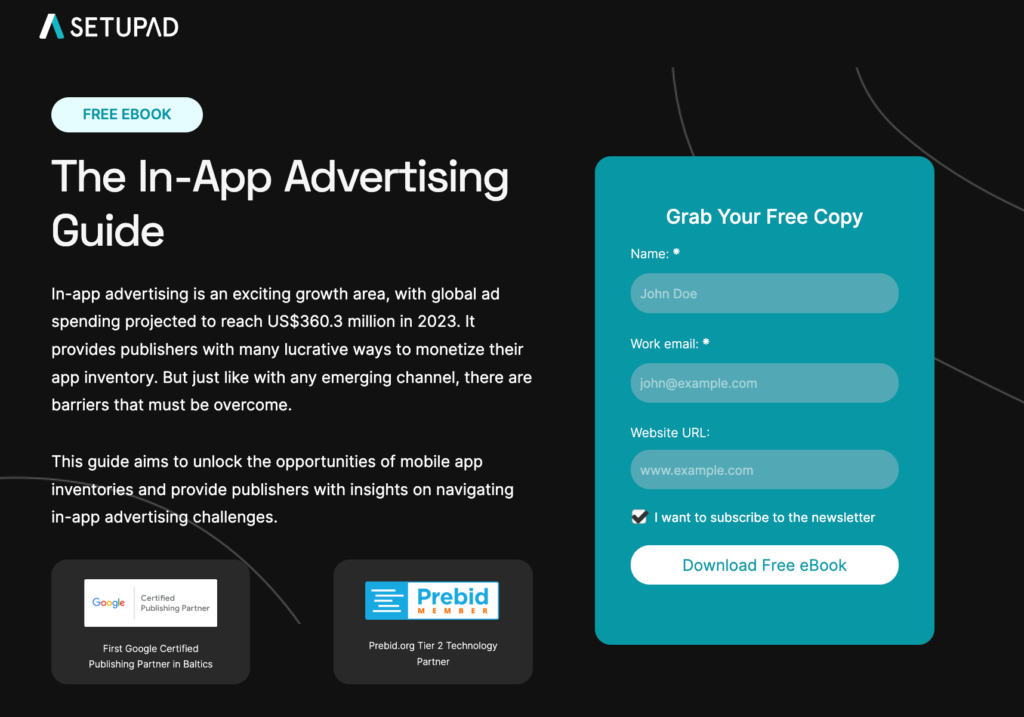How to Increase Ad Revenue in 2024 | Success Formula and 5 Best Strategies
There is a “publishers’ success formula” (as we like to call it) you should know! Remember that your ad revenue doesn’t depend only on your monetization partner and the number of ads displayed.
It also depends on your website’s audience, loyalty, engagement, and the quality of your ad inventory.
In this article, you will learn how to calculate your ad revenue using our free ad revenue calculator, and which metrics to focus on to boost your ad revenue.
Key Metrics for Calculating Your Ad Revenue
While there are a myriad of formulas that can be helpful for estimating an ad revenue of the website, most of them will take two things into account–user behaviour and monetization strength. Simply speaking, a formula to calculate ad revenue usually takes certain metrics and multiplies them, while the result is an ad revenue.
Key website metrics
These are users representing your website’s audience, their loyalty, and engagement.
Audience–users who are visiting your website for over a month.
Loyalty–a metric that shows how many times users return to a website on average per month (also known as Returning visitors).
Engagement– is a metric that shows how many page views, on average, users generate during their visit session (also known as Pageviews per user/ Pageviews per user for a cohort).
Key monetization metrics
Ad Inventory– the amount of available ad space on the publisher’s website. It also refers to the number of ad placements available to sell to advertisers. Naturally, if you have 1 ad per page, the value of ad inventory will be 3 times lower than if you had 3 ads per page.
Price– it represents the amount of money for how much you sell your ad inventory. The price is calculated in banner impressions, usually as a CPM (price for 1000 impressions).
To calculate the formula, consider one month as a period.
Ad Revenue Formula

As you can see, the number of users influences the revenue potential, but the full picture consists of understanding how often and how engaged these users are.
Experienced publishers will know that there are more factors at play, for example, where your traffic comes from. This is why take the price for 1000 ad impressions, which determines how valuable the traffic is (traffic in Tier 1 countries is considered more valuable for advertisers as opposed to Tier 2 or Tier 3 countries, which results in higher prices).
Each metric on its own represents a different strategy and approach to how to increase ad revenue.
Before we dig more into strategy, let us give you an example of how you can use Google Analytics to calculate the success formula.
How to Calculate Ad Revenue Using Google Analytics?
1. Open your Google Analytics
2. Go to the left sidebar and press Audience, then Overview.
3. To calculate your potential ad revenue choose one month as a period, in this example we choose July 1- 31, 2020.
According to the picture below, there were 188734 users per month. Each of these users has returned to the page 1.23 times per session and visited 2.08 pages on average.
(188734×1.23×2.08xAdsxPrice)/1000=Revenue

4. Let’s imagine you’re displaying 4 ads on your website. The price represents the CPM metric, which illustrates the ad revenue generated from 1000 ad impressions of banners. Let’s say in this case, your CPM is 0.50EUR
(188734×1.23×2.08x5x0.50)/1000=1207EUR
Your potential ad revenue is 1207EUR.
For a seamless ad revenue calculation using Google Analytics data, you can use Setupad’s free ad revenue calculator.

5 Strategies to Grow Your Ad Revenue
As we mentioned earlier, each of the formula’s metrics represents different strategies to increase your website’s ad revenue.
Let’s imagine that your website is quite fresh and new. It has 30 000 visitors (users) per month, who, on average, visited the site 1.3 times and viewed 1.5 pages. There are 5 ads per page on average, and the CPM is 0.40EUR.
Here’s a formula to calculate ad revenue for this website:
(30 000 x 1.3 x 1.5 x 5 x 0.40)/1000=117EUR
Let’s now imagine that efforts were made to increase the number of users, their loyalty, and engagement by 30% in total. Also, 1 ad placement was added, and the CPM, after the optimization Setupad provided, increased to 0.50EUR.
(39000×1.69×1.95x6x0.50)/1000=385,57EUR
The revenue increased from 117EUR to 385,57EUR, which is more than 300%! The whole growth was created just by growing the key metrics of the revenue potential.
Let’s now look at 5 strategies to help you improve each metric in the formula:
1. Grow your user count
- Follow SEO best practices
- Improve internal and external linking structure
- Improve content distribution strategy by using more social channels
- Use the right amount and well visible social icons
- Get featured in Google News & Google Discover
2. Improve user loyalty
- Offer users to sign-up for a newsletter using a pop-up banner or a sing-up button within main content
- Offer push notifications for users
- Let users leave comments and actively participate
- Provide extra value for loyal users in the form of lead magnets such as downloadable PowerPoint templates and .pdf books.

Source: Setupad
3. Increase user engagement
- Offer related/recommended articles both inside of the article and at the bottom of it
- Improve the recirculation strategy by making a header menu sticky for mobile users
- Use more interactive media, such as video content and rich media
- Increase the website loading speed of your website
- Improve your Core Web Vitals
4. Experiment with ad count
Don’t be afraid to test and display ads on different ad placements. However, don’t clutter your website with too many ads. It could harm not only the first three key metrics of the formula but also reduce the eCPM.
5. Increase your CPM
Growing the CPM is a complex approach that Setupad can help in.
In every website optimization journey, we begin by calculating a viewability-focused ad setup, working out the best ad layout, and improving the yield by using an optimal number of premium demand partners and a light Prebid technology. This consistently improves the value of ad inventory, pushing advertisers to bid higher CPMs.
Conclusion
We want to emphasize one more time that CPM and ad placements are not the most important things you should consider when calculating ad revenue.
Make sure that you know your target audience and keep creating quality content that will allow you to increase the number of returning visitors.
Another point you should remember is that if you increase one or more variables, your ad revenue will be higher.
Increase your ad revenue with us by signing up!


